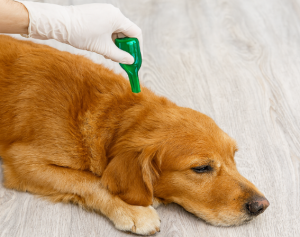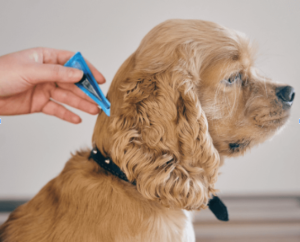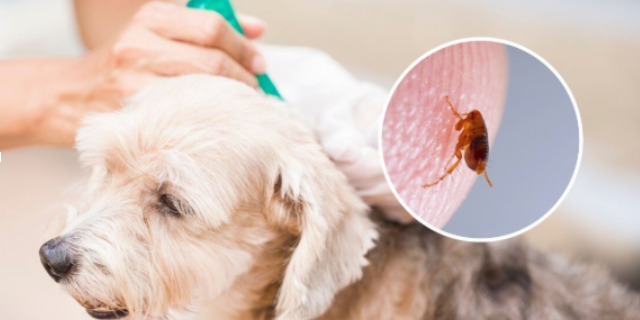Flea prevention for dogs is essential to protect your pet from harmful parasites. Fleas and ticks are more than just seasonal pests; they can cause skin irritation, allergic reactions, and even transmit serious diseases. These tiny invaders pose a constant threat to your dog’s health, but with the right strategies and treatments, you can keep your dog protected throughout the year.
In this guide, we’ll cover everything from when to start flea prevention to how to choose the best medicine, as well as actionable home care tips to reduce the risk of infestation.
Why Flea and Tick Prevention Is Critical for Your Dog’s Health
Flea and tick infestations are not only uncomfortable but can quickly lead to serious health problems. Preventive care isn’t optional; it’s essential.
Health Risks of Fleas
- Flea Allergy Dermatitis (FAD): A hypersensitive reaction to flea saliva. It leads to intense itching, skin redness, and infection.
- Anemia: Severe flea infestations can cause blood loss, particularly in puppies or small breeds.
- Tapeworms: Dogs often ingest fleas during grooming, which can result in tapeworm infections.
Health Risks of Ticks
- Lyme Disease Can cause fever, lethargy, and joint pain.
- Ehrlichiosis and Anaplasmosis: Tick-borne diseases that damage blood cells and immune function.
- Paralysis Ticks: Found in some regions, their toxin can cause paralysis or even death without treatment.
When to Start Flea and Tick Protection for Your Dog
Many dog owners wait until fleas are visible, but by then, it’s too late. Prevention should be proactive, not reactive.Start Early for Puppies
Most flea prevention products can be used safely from 6 to 8 weeks of age. Ask your vet to recommend products suited to your puppy’s size and breed.
Flea Season Never Ends
- Warm Climates: Fleas and ticks thrive all year in humid and tropical areas.
- Cold Climates: Fleas can survive indoors, even in winter, particularly in homes with heating.
- Year-Round Prevention Is Ideal: Even during the winter, flea eggs can lie dormant and hatch under the right conditions.

Indoor Dogs Aren’t Immune
Fleas can hitch a ride inside on clothing, shoes, or other pets. Indoor dogs are still at risk without consistent prevention.
How to Choose the Best Flea and Tick Medicine for Your Dog
With numerous products available, selecting the proper flea prevention can be overwhelming. Here’s how to make an informed choice:
1. Pick the Right Application Method
- Topical Treatments: Applied between the shoulders; effective but can wash off with baths.
- Oral Medications: Chewable tablets, such as Simparica or NexGard, are clean and mess-free.
- Collars: Long-lasting options, such as Seresto, offer protection for up to 8 months.
2. Consider Your Location
- Dogs in tick-heavy regions or near wooded areas need stronger protection.
- Urban pets may do fine with monthly topical treatments if exposure is minimal.
3. Think About Outdoor Exposure
Does your dog often go hiking, swimming, or to the dog park? More exposure equals higher risk, which necessitates stronger prevention measures.
4. MDR-1 Gene Sensitivity
Breeds like Collies and Australian Shepherds may be predisposed to react poorly to certain medications due to a genetic mutation. Always consult your veterinarian before using ivermectin-based medications.
5. Match to Your Dog’s Lifestyle
Active dogs may need waterproof or long-acting products. Less active or senior dogs might benefit from gentler options.
6. Age and Life Stage
- Puppies require specific low-dose treatments.
- Seniors may have health conditions requiring vet-approved alternatives.
7. Consider Existing Health Issues
If your dog has epilepsy, liver issues, or skin sensitivities, avoid over-the-counter products. Prescription options will offer safer control.
Over-the-Counter vs. Prescription Flea Prevention: What’s the Difference?

Both options can be effective, but knowing the pros and cons helps you make the right choice.
Over-the-Counter (OTC) Products
- Pros: Affordable, widely available, and user-friendly.
- Cons: May be less effective in severe infestations; fleas in some areas have developed resistance to this treatment.
Popular OTC brands include:
- Frontline Plus
- Advantix II – sold at Dashing Dawgs Groomin and Boutique
- Seresto Flea Collars
Prescription Treatments
- Pros: Often more powerful and fast-acting. Usually covers multiple parasites, including ticks, heartworms, and intestinal worms.
- Cons: Costlier and require a veterinary prescription.
Top prescription options:
- Simparica Trio
- Bravecto
- NexGard
- Revolution Plus
Which Should You Choose?
If your dog has health issues or has already been infested, prescription options offer a better guarantee. For low-risk dogs, OTC products may be enough, but always check with your vet.
Smart Flea Prevention Tips for Your Home and Yard
Good flea prevention goes beyond medication. Environmental management is key to long-term protection.
1. Keep Your Dog’s Environment Clean
- Wash all bedding weekly in hot water.
- Vacuum carpets, rugs, and furniture on a regular basis.
- Use flea sprays or powders in high-traffic areas.
2. Treat the Yard
- Mow regularly and trim back bushes.
- Apply pet-safe outdoor flea treatments.
- Use natural options, such as nematodes or diatomaceous earth, to control larvae in the soil.
3. Routine Grooming
- Brush your dog with a flea comb once or twice a week to remove fleas.
- Pay attention to the neck, belly, tail base, and armpits—common flea hiding spots.
- Bathe monthly with flea-repelling shampoo during peak seasons.
4. Travel Preparedness
- Bring flea prevention when traveling.
- Check your dog for fleas and ticks after hikes, visits to dog parks, or trips to the beach.
- Clean travel bedding and crates thoroughly after each use.
Final Thoughts: Consistent Flea Prevention = A Healthier, Happier Dog
Flea and tick prevention isn’t just about stopping the itch, it’s a critical part of your dog’s long-term health plan. Whether you’re using monthly topicals, chewable tablets, or long-lasting collars, the key is consistency. Prevention is far easier (and cheaper) than dealing with a full-blown infestation.
Consult with your veterinarian, assess your dog’s lifestyle, and select a product that meets their specific needs. Combine medical treatments with regular home care to ensure your furry friend remains protected throughout the year.
Frequently Asked Questions
- What is the most effective flea repellent for dogs?
Prescription treatments, such as NexGard, Bravecto, and Simparica Trio, are considered the most effective, offering protection against fleas, ticks, and other parasites. - What is the best way to protect your dog from fleas?
Use vet-recommended flea prevention consistently, clean your dog’s environment, and groom your pet regularly to catch fleas early. - Do dogs need flea treatment every month?
Yes. Most flea preventatives are designed for monthly application to stay effective. Skipping a dose can increase the risk of infections. - Do flea collars work?
Yes, especially high-quality options like Seresto. They offer long-lasting protection but should be combined with other treatments in high-risk areas. - Can fleas live in bedding?
Absolutely. Fleas and their eggs can survive in dog beds, carpets, and furniture. Regular washing and vacuuming are essential.





